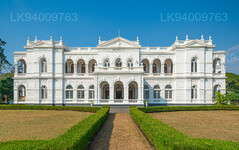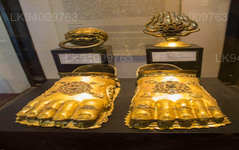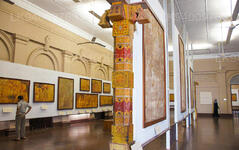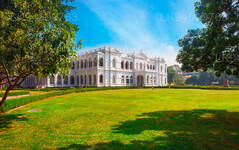
Colombo-stad
Colombo, de hoofdstad van Sri Lanka, is een dynamische stad die traditie en moderniteit combineert. Je vindt er koloniale architectuur, levendige markten en serene boeddhistische tempels. Met een gevarieerde keuken, een groeiende skyline en prachtige stranden is het een bruisend centrum voor zaken, cultuur en toerisme, en een ideale uitvalsbasis om de wonderen van Sri Lanka te verkennen.
National Museum
National Museum of Sri Lanka: The House of History
The National Museum of Sri Lanka, also most commonly known as the Sri Lanka National Museum is cosidered to be the largest Museum in Sri Lanka. It is maintained by its own dedicated Department of National Museum in Sri Lanka. It is home to many valuable and historically important objects such as the throne and the crown of the Kandyan Monarchs.
National Museum of Sri Lanka: The Story behind the History
The Colombo Museum was established in 1st January 1877. It was founded by the British Governor of Ceylon at the time; Sir William Gregory.
The architect of the Public Works department, J.G. Smither was able to prepare plans for the new structure based on Italian architecture style.
The construction of the Museum was carried out by Arasi Marikar Wapchie Marikar (born 1829, died 1925, aka Wapchi Marikar Bass. Wapchi Marikar Bass has an extensive resume that made him the perfect man for this immense project. He was the builder of the General Post Office in Colombo, Colombo Customs, Old Town Hall in Pettah, Galle Face Hotel, Victoria Arcade, Finlay Moir building, the Clock Tower, Batternburg Battery and many other buildings some of which are still standing today. The construction was completed in 1876 and commissioned to be opened the following year. The completed building of the Colombo Museum was declared open by Governor Gregory, in the presence of a large crowd.
Several other wings were added from time to time under the direction of Dr. Arthur Willey and Dr. Joseph Pearson new structures were built during the period of Dr. P. E. P. Deraniyagala, Dr. P. H. D. H. de Silva and Sirinimal Lakdusinghe. One of the natural history museum, and yet another consists of the auditorium.
National Museum of Sri Lanka: Recent developments
The museum was given the status of a national museum during the period of P. E. P. Deraniyagala. Under his supervision branch museums were opened in Jaffna, Kandy, and Ratnapura and a fully-fledged department of national museum was established in 1942 under the act No. 31. Nine branch museums were ultimately opened, and a school science program and a mobile museum law essay writing uk service are also in operation.
National Museum of Sri Lanka: The Library
Along with the Colombo National Museum the Library was also established in the 1st of January in 1877. The Government Oriental library (1870) was incorporated in to Colombo National Museum Library, and served as the nucleus of the library collection by collecting the local publications during the past 129 years.This huge collection of the library could be separated in to various groups according to the document type.
1. Palm leaf collection which are written in Sinhala, Pali, Sanskrit, Burmese, Telegu and Tamil characters among the subjects covered are Buddhism, Sinhala literature, History, Indigenous Medicine, Astrology, Demonology, Veterinary Science, Art, Architecture and Folklore.
2. Printed books and Pamphlets, This collection comprises the entire range of documents from the first work printed in 1737 to the latest book.
3. Periodical collections such as Journal of the Royal Asiatic Society (CB), Ceylon Antiquary and Literary Register, Young Ceylon etc. The collection was built up to a great extent by exchanges received from the institutions in all parts of the globe. Foreign periodical collection contains important titles such as discovery reports, Ray Society publications among many others.
4. Government Publications such as Blue books from 1864-1938, Administration Reports from 1867 to date, Sessional papers from 1860 up to date, Hansards
from 1863-1962 etc.
5. Directories, Statistical year books, Trade catalogues etc.
6. Law Reports
7. Maps and Drawings
National Museum of Sri Lanka: Photography Division
The Photography Division of the Department of National Museums was established in 1950. Photographs related to the museum objects supply to other divisions of the department and external parties is the main task of this division.
Services of this division are:
Photograph museum objects, faunal and floral specimen, geological items and supply photographs to the relevant divisions where necessary. Sale of photographs of museum objects to external parties with the orderly approval from the Director. Negatives, photographs taken by the digital camera store on CD’s, registration and conservation.
National Museum of Sri Lanka: Information Technology division
The Information Technology division of National Museum of Sri Lanka is used to archive the all the data in the Museum and save it in a safe form. It also takes care of online queries and maintaining the museum web page.
Over het district Colombo
Colombo is de grootste stad en commerciële hoofdstad van Sri Lanka. Het ligt aan de westkust van het eiland en grenst aan Sri Jayewardenepura Kotte, de hoofdstad van Sri Lanka. Colombo is een drukke en levendige stad met een mix van modern leven en koloniale gebouwen en ruïnes, en een stadsbevolking van 647.100. De metropoolregio Colombo, gedefinieerd door de districten Colombo, Gampaha en Kalutara, heeft een geschatte bevolking van 5.648.000 en beslaat een oppervlakte van 3.694,20 km². Colombo is een multi-etnische, multiculturele stad. Het is de meest bevolkte stad van Sri Lanka, met 642.163 mensen die binnen de stadsgrenzen wonen. De bevolking van Colombo is een mix van verschillende etnische groepen, voornamelijk Singalezen, Moren en Tamils. Er wonen ook kleine gemeenschappen van mensen met Chinese, Portugese, Nederlandse, Maleisische en Indiase afkomst in de stad, evenals talloze Europese expats. De overgrote meerderheid van de Sri Lankaanse bedrijven heeft hun hoofdkantoor in Colombo. Enkele van de industrieën die er actief zijn, zijn chemie, textiel, glas, cement, lederwaren, meubels en sieraden. In het stadscentrum staat het op één na hoogste gebouw van Zuid-Azië: het World Trade Centre.
Over de Westelijke Provincie
The Western Province is the most densely populated province of Sri Lanka. It is home to the legislative capital Sri Jayawardenepura Kotte as well to Colombo, the nation's administrative and business center. Western Province is divided into 3 main districts called Colombo (642 km²), Gampaha (1,386.6 km²) and Kalutara (1,606 km²) districts. As Sri Lanka's economic hub, all the major local and international corporations have their presence in the city and so do all the major designer and high street retailers, so be ready to indulge in some retail therapy in western province.
Having the highest population in the all the provinces, the almost all the premier educational institutions in the island are located in western province. Universities in the province include the University of Colombo, the University of Sri Jayewardenepura, University of Kelaniya, Open University, Sri Lanka, Buddhist and Pali University of Sri Lanka, General Sir John Kotelawala Defence University and University of Moratuwa .Western province has the largest amount of schools in the country, which includes National, Provincial, Private and International schools.










































